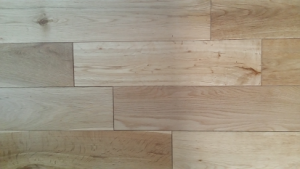Moisture in oak flooring

Oak Wood Floor
Oak wood flooring. Looks fantastic, feels solid to walk on and does not give a home to cat/dog fleas or house mites. Oak is heavy and hard and when laid down on top of a concrete floor you would think it should be pretty much rooted in place. Most of the time it does just sit under your feet just as solid as you would imagine. That is until the tiniest little thing called a water molecule invades the oak, not just a single one but, in fact, billions of them, known as moisture. When this happens the wood expands and the lovely solid oak floor becomes a springboard. We experienced this in our bedroom where the wooden boards had pushed against each other and we could see them buckling up. The curve was so great that it stopped a door opening! We had not spilled any water or had a flood, so what happened?
Wood naturally interacts with moisture
Wood is a natural material and like all natural materials interacts with moisture in the air. When this occurs depends on an interesting property of a link between wood and moisture. A big factor is the amount of moisture in the air. High levels of moisture in the air causes more moisture to enter the wood. One way of measuring moisture is “relative humidity” which is calculated as a percentage as written as %RH. I explain in the first chapter of my eBook “A Wet Look At Climate Change” why it is called “relative” and also explain how %RH is used as a measure of moisture in the air.
Back to the wood and moisture. Using a small %RH meter and a jam jar I worked out that our oak flooring only takes up moisture when the %RH is above 70%. Putting it another way, there is a “natural” equilibrium between the oak wood flooring that means it is quite happy to be a flat wooden floor so long as the room humidity is below 70%. Above this humidity level, moisture penetrates into the wood and causes it to swell. Knowing this solved a mystery. Most of the time the flooring was fine but at certain times of the year, usually as we moved into Autumn, the buckling problem reappeared. Why Autumn? As I explain in my Autumn blog post this is when the weather causes an increase in humidity and it is also before we turn on the house heating. So, more cool moist air coming into the house causes the bedroom air to get above 70% and that’s the reason for the buckled floor. Rather than heat the room to bring down the %RH, we use a dehumidifier if the %RH stays above 70% for more than a couple of days.
Measuring moisture in wood
Other types of wood also interact with moisture. In fact, every wood has its own unique way of dealing with moisture. People have studied what happens when wood takes up or loses moisture and it is very complex. Not only does it depend on the type of wood but also on the grain and how the wood is cut. There is a load of literature on this subject. One site I came across on measuring moisture in wood includes a table of many different types of wood which is worth looking at to give you some idea of the range of moisture content. What I particularly like about this blog is the inventiveness in making a moisture meter from a couple of nails, a battery and a multimeter! Also on the Woodgears website is an article on seasonal changes in wood that is directly related to my oak wooden flooring problem.
Finally, to finish off and drive home the difficulty of working with wood in a world of moisture, here’s an article from Vaisala, a company that has for many years specialised in measuring humidity, called Improve Your Wood Drying Process with Accurate Humidity Measurements. Each application has to be thought about and almost customised to be sure of getting reliable results. This particular article is all about the very real difficulty of measuring moisture levels in wood.
If you would like to hear more about moisture and humidity in everyday life, please sign up for email alerts of my blogs.
Welcome to my world of moisture

Leave a Reply